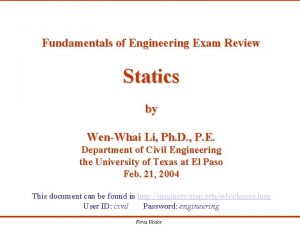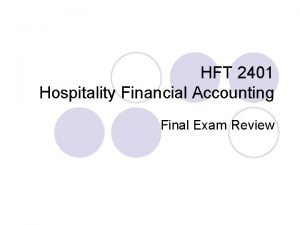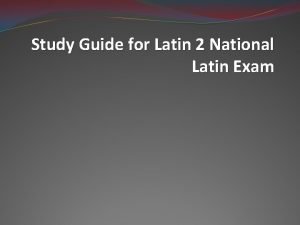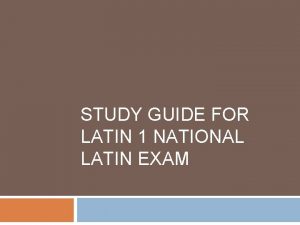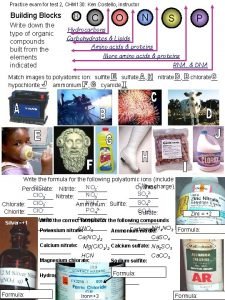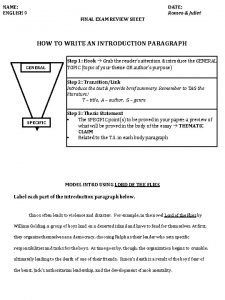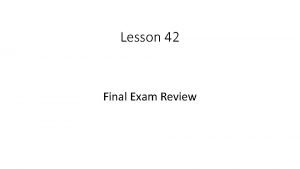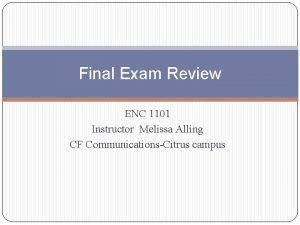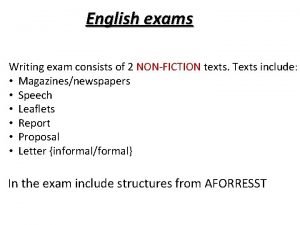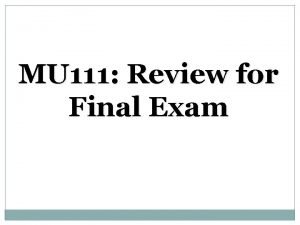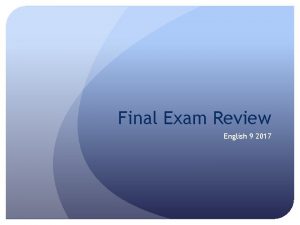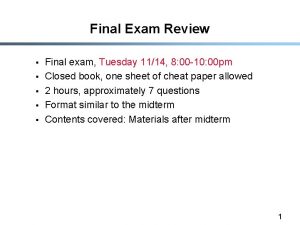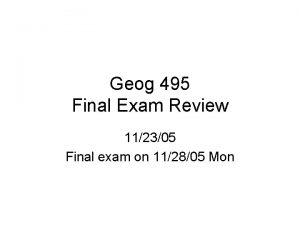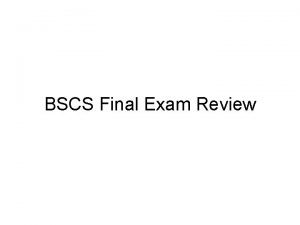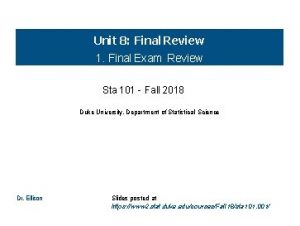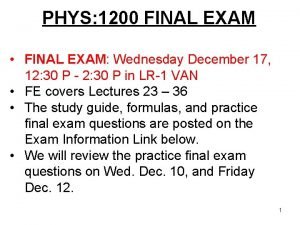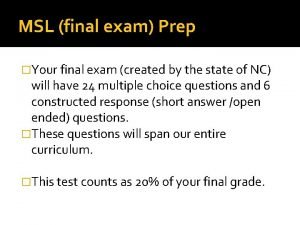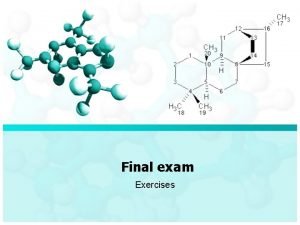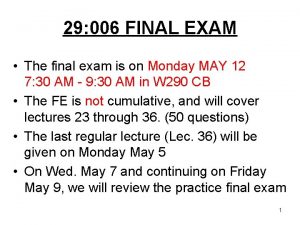CS 1 Final Exam Review Mr Crone Convert















































- Slides: 47

CS 1 Final Exam Review Mr. Crone

Convert 101101 from binary to decimal.

Convert 101101 from binary to decimal. 101101 Base 2 = 45 Base 10

Convert 78 from Base 10 to Base 2.

Convert 78 from Base 10 to Base 2. 78 Base 10 = 1001110 Base 2

Is C++ considered a high-level or low level programming language?

Is C++ considered a high-level or low level programming language? High-Level

Is C++ object oriented or procedural based?

Is C++ object oriented or procedural based? Object Oriented

How many bits are in 3 bytes?

How many bits are in 3 bytes? 24 bits in 3 bytes

ASCII and Unicode are used to convert binary into…

ASCII and Unicode are used to convert binary into letters, numbers, and symbols.

Software can be broken down into two types: ____ and _____ software.

Software can be broken down into two types: system and application software.

Which of the operators below has the highest precedence? &&, ||, !

Which of the operators below has the highest precedence? &&, ||, ! ! has the highest precedence

Which of the operators below has the highest precedence? &&, ||

Which of the operators below has the highest precedence? &&, || && has the highest precedence

What does the code below print? cout << double(5)/4 << endl;

What does the code below print? cout << double(5)/4 << endl; // Prints: 1. 25

What does the code below print? cout << double(5/4) << endl;

What does the code below print? cout << double(5/4) << endl; // Prints: 1

What does the code below print? int var 1 = 4, var 2 = 3; const var 3 = 15; cout << var 1 + var 2 + var 3 <<< endl;

What does the code below print? int var 1 = 4, var 2 = 3; const var 3 = 15; // ERROR! cout << var 1 + var 2 + var 3 <<< endl;

What is the assignment operator?

What is the assignment operator? =

Name the relational operators.

Name the relational operators. <, >, <=, >=, ==, !=

Name the logical operators.

Name the logical operators. &&, !, ||

Name the increment and decrement operators.

Name the increment and decrement operators. ++, --

Name the shortcut assignment operators.

Name the shortcut assignment operators. +=, -=, *=, /=, %=

Which of the operators below has the highest precedence? -, +, %

Which of the operators below has the highest precedence? % (Modulus)

The code below creates a random number in what range? int r 1 = rand() % 10 + 4

The code below creates a random number in what range? int r 1 = rand() % 10 + 4 [4, 13]

Provide two examples of escape sequences.

Provide two examples of escape sequences. n, t

What does the code below print? cout << int(3. 7) << endl;

What does the code below print? cout << int(3. 7) << endl; // 3

What does the code below print? string str = “Northern Pike”; cout << str. at(6) << endl;

What does the code below print? string str = “Northern Pike”; cout << str. at(6) << endl; //Prints: r

What does the code below print? string str = “Northern Pike”; cout << str. find(“the”) << endl;

What does the code below print? string str = “Northern Pike”; cout << str. find(“the”) << endl; //Prints: 3
 Ap gov review final exam review
Ap gov review final exam review Andy crone
Andy crone Patricia crone hagarism
Patricia crone hagarism Baylee crone
Baylee crone World history spring final exam review answers
World history spring final exam review answers Spanish 1 review packet
Spanish 1 review packet Pltw human body systems final exam review
Pltw human body systems final exam review Truss practice problems poe
Truss practice problems poe Ied final exam review
Ied final exam review World history semester exam
World history semester exam Principles of business final exam answer key
Principles of business final exam answer key Spanish 2 final exam review packet
Spanish 2 final exam review packet Pa state tree
Pa state tree World history final exam study guide
World history final exam study guide Us history semester 2 final exam review
Us history semester 2 final exam review English 11 semester exam
English 11 semester exam Physics 20 final exam practice
Physics 20 final exam practice Physical science final exam study guide
Physical science final exam study guide Mat 1033 final exam answers
Mat 1033 final exam answers Statics exam 3
Statics exam 3 Zoology final exam review
Zoology final exam review Earth science final
Earth science final Algebra 1 final review packet
Algebra 1 final review packet Accounting final review
Accounting final review Personal finance final exam review
Personal finance final exam review Spanish 2 final exam review
Spanish 2 final exam review Psyc 1504 final exam
Psyc 1504 final exam World geography spring final review
World geography spring final review Web design final exam
Web design final exam American history final exam
American history final exam Sbu finals schedule
Sbu finals schedule Latin 2 final exam
Latin 2 final exam National latin exam answers
National latin exam answers Street law final exam
Street law final exam What is the answer
What is the answer Realidades 2 final exam
Realidades 2 final exam Chemistry 151 final exam
Chemistry 151 final exam Chem 130 final exam
Chem 130 final exam Romeo and juliet final exam study guide
Romeo and juliet final exam study guide 42 final exam
42 final exam Aice general paper final exam
Aice general paper final exam Human resource management past papers and answers
Human resource management past papers and answers Hospitality and tourism final exam
Hospitality and tourism final exam Hbs practice test
Hbs practice test Animal science final exam
Animal science final exam Enc 1101 final exam
Enc 1101 final exam Vector safe schools training quiz answers
Vector safe schools training quiz answers Simile in writing
Simile in writing



















